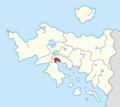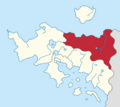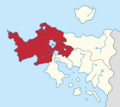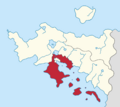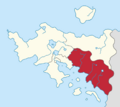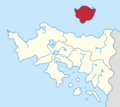Meckelnburgh: Difference between revisions
| Line 124: | Line 124: | ||
=== Biodiversity and conservation === | === Biodiversity and conservation === | ||
The growth of iron ore mining in the north Comstokia Mountains in Meckelnburgh has sparked local development initiatives and exponential economic activity. However, this expansion has also posed certain challenges, including environmental concerns related to mining practices and the need for sustainable resource management. Mining has numerous hazards, from habitat destruction by mining camps to acid mine drainage and toxic mining tailings. | |||
=== Topography === | === Topography === | ||
| Line 276: | Line 276: | ||
== Economy == | == Economy == | ||
Meckelnburgh emphasizes the [[Wikipedia:Welfare state|welfare state]] within an advanced [[Wikipedia:Mixed economy|mixed market]]. Its government has large [[Wikipedia:State-owned enterprise|ownership positions]] in many sectors, including industrial and entertainment. Gambling is the largest income source for the Crown itself. In Meckelnburgh, manufacturing—automotive, electronic, and consumer goods—is the largest | Meckelnburgh emphasizes the [[Wikipedia:Welfare state|welfare state]] within an advanced [[Wikipedia:Mixed economy|mixed market]]. Its government has large [[Wikipedia:State-owned enterprise|ownership positions]] in many sectors, including industrial and entertainment. Gambling is the largest income source for the Crown itself. In Meckelnburgh, manufacturing—automotive, electronic, and consumer goods—is the largest economic sector. Meckelnbuirgh is also known for its construction toy sets from [[LUZO Byllundt]], headquartered near Alexandretta. | ||
=== Energy === | === Energy === | ||
| Line 282: | Line 282: | ||
=== Agriculture and natural resources === | === Agriculture and natural resources === | ||
The economy of Meckelnburgh relies significantly on its agriculture and animal resources sector, which stands as the second largest contributor to the region's economic activity. This sector plays a crucial role in supporting both local food needs and external export markets. | |||
Cereal grains form a substantial part of Meckelnburgh's agricultural output. The favorable climates found in the Treynor Archipelago and around Crowsilver Sea facilitate the cultivation of staple crops such as wheat, barley, and oats. These grains not only provide sustenance for the local population but also serve as a vital resource for the production of cereal grain alcohols, contributing to the region's manufacturing sector. Meckelnburgh also includes a significant focus on animal husbandry. Sheep husbandry is a prominent activity, yielding high-quality wool that finds applications in textiles and clothing production. Additionally, the eastern Clanlands are home to a diverse array of wild game, providing a valuable source of furskins. These furs are sought after for their warmth and aesthetic appeal, building Meckelnburgh's traditional fur trade. | |||
The extraction of forest resources, particularly timber, is another fundamental Meckelnburgh industry. The practice of forest cutting has been a longstanding tradition, supplying the region with quality timber for construction, furniture making, and other industries. Moreover, a substantial portion of the timber is processed into wood pulp, a key ingredient in the manufacture of paper products. The expertise of Meckelnburgh's paper production has resulted in the creation of a variety of paper products for book manufacturing and visual arts. | |||
=== Mineral resources === | |||
The north Comstokia Mountains in the Brittnay province, characterized by their mineral-rich composition, have become a focal point for the burgeoning iron ore mining industry in Meckelnburgh. The exploration and extraction of iron ore are driven by the demand for this vital raw material in industrial applications, most notably in the production of steel. The establishment of the iron ore mining sector has brought several economic implications for Meckelnburgh. The newfound availability of iron ore caters to domestic manufacturing for personal automobiles and light-duty trucks, as well as potential export. | |||
=== Water supply and sanitation === | === Water supply and sanitation === | ||
Revision as of 07:29, 7 August 2023
- "MCK" redirects here. For the sovereign nation with a similar name, see Kingdom of Meckelnburgh.
| Meckelnburgh | |||
| |||
| Motto: "Aŭguro de pli bonega tempaĝo" (ao) "An Omen of a Greater Age" | |||
| Anthem: "Ode to Our King and Flag" | |||
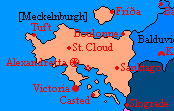
| |||
| Map versions | 16.8.4– | ||
| Capital and largest city |
Alexandretta | ||
| Official language | Istvanistani | ||
| National languages | Meckelnish · Aspiranto · Alexandrian | ||
| Recognized regional languages | Eastmoorlandish · Froyalanish | ||
| Ethnic groups | 76.8% Meckelnish (all tribes) 7.6% Britannics 3.5% Froyalaners 2.7% Valtians 1.2% Seal Fishers 0.6% Black Travellers 0.4% Jääkieli 7.2% Other | ||
| State religion | Church of Meckelnburgh | ||
| Religious affiliation | 57.0% Irreligious 37.1% Nazarene —27.3% Albigensian —7.1% Catholic —0.8% Orthodox —1.9% Other 3.2% Ethnic religions 1.1% Ashkenatzi 1.6% Other | ||
| Demonyms | Meckelner | ||
| Adjectives | Meckelnburghish · Meckelnish | ||
| Government | Unitary parliamentary semi-constitutional monarchy | ||
| • Monarch | Ĉielero III | ||
| • Chancellor | Masterman Gibbs | ||
| • Vice Chancellor | Christine Alfons | ||
| • Viceroy in Hergilsey | Sir Óðinn Gunnarsson, Bt. | ||
| • Lord Speaker | Lord Wilburn Arkwright, 7th Baron Townsville | ||
| • Chamber of Deputies President | Émilien Plamondon | ||
| • Chief Justicar | Lord Colin Blackwood, Lord Ordinary of Appeal | ||
| Legislature | Parliament | ||
| • Upper house | College of Lords | ||
| • Lower house | Chamber of Deputies | ||
| Formation (Norton) | |||
| Admitted to the Micras Cartography Society | 13.V.1685 AN | ||
| Current constitution | 2.XV.1697 AN | ||
| Formation of the Meckelnburghish realm | 23.XIII.1709 AN | ||
| Meckelnburgh Partition | 1.X.1721 AN | ||
| Area | |||
| • Total | 429,900 km2 (165,985 sqmi) | ||
| • Water | 1.767% | ||
| Population | |||
| • 1722 AN estimate | 6,608,456 | ||
| • Density | 15.37/km2 (39.81/sqmi) | ||
| Currency | Meckelnburgh rixdollar (Ʀ) (MBD) | ||
| Time zone | CMT-1 (MST) | ||
| Calendar | Norton Calendar | ||
| Driving side | right | ||
| Abbreviation | MCK | ||
| Internet TLD | .mb | ||
Meckelnburgh (/mɛk.əln.bɜɹg/ MEK-əln-burg) is a northern Apollonian country that is part of the Kingdom of Meckelnburgh. The state is one of three constituent countries that form the Kingdom, along with the Prince-Archabbacy of Salem and the Grand Duchy of Iselande; the people of all three being Mecklenburgish citizens. It has a total area of about 153,000 km2 (59,000 sqmi) with a population of 6.6 million as of 1722 AN. The capital and largest city is Alexandretta.
The country lies on the Genevelond Peninsula at the end of the fabled Teir'Dal Corridor, bordering with Lac Glacei and Ashinthael. Meckelnburgh holds Glanurchy Island in the north, as Palatinate of Hergilsey, and the Treynor Archipelago to the south, as the province of Savalim. The Comstokia Mountains cross its east and the Koranga Plains in its west. The majority of the population resides around Alexandretta and the second largest city Victoria, along Crowsilver Bay and at the end of the Siegrwang Peninsular.
Meckelnburgh is a unitary state with four provinces, a royal city, and an autonomous region. Meckelnburgh is divided between "mainland" Meckelnburgh—which includes the Treynor Archipelago—and the Palatinate of Hergilsey, an autonomous region on Glanurchy Island. Hergilsey has privileges of a devolved province with the Queen-in-Right as Countess Palatine, but votes in Meckelnburgh national elections.
The country is a parliamentary semi-constitutional monarchy with an empowered head of state, Queen Ĉielero III. Parliament is the bicameral legislative and highest judicial authority of Meckelnburgh, consisting of the noble College of Lords and the common Chamber of Deputies. The head of government is Marie-Claude Giraud, who is likewise responsible to Parliament. The Church of Meckelnburgh is the state religion.
Meckelnburgh is the original constituent state that developed into the wider Meckelnburghish Realm. As the country proper constitutes the majority of the kingdom’s land area and population, it is responsible for much of the kingdom’s administration and governance, whose capital is likewise Alexandretta.
Etymology
The name "Meckelnburgh" derives from the Old Holzer term for the Alexandretta Fortress, where it meant "broad fortress." The original fortress stands still on the shores of the Gulf of Geneva, since renamed for the capital city it lies in. Following the unification of the Meckelnish tribes, the name was adopted as a symbol of the kingdom as a whole after unification.
Both "Meckelnburghish" and "Meckelnish" are demonyms for people and things associated with Meckelnburgh. "Meckelnburghish" refers to the government of Meckelnburgh and its institutions (e.g. Meckelnburghish throne) while "Meckelnish" refers to the peoples of Meckelnburgh and their culture (e.g. Meckelnish language). The distinction is especially important to maintain the relationship between the three traditional cultures of the country.
Geography
[Insert]
Climate
The Kingdom of Meckelnburgh is one of the coldest nations on Micras, residing almost entirely within polar tundra and boreal climate zones. Meckelnburgh is the warmest of all three constituent countries.
In the north, the Palatinate of Hergilsey is covered almost entirely in polar tundra, save a small section of its south shores. Most of the remaining country, including the majority of the Genevelond Peninsula, is continental boreal. Due to the influence of Tallandor Bay, the far eastern shore of Cumberland province, the Treynor Archipelago and the southernmost part of the Siegrwang Peninsular, near the city of Victoria, are classified as humid continental with "warm" summers.
Parts of Meckelnburgh have no months with an average temperature above 10 °C, as in Hergilsey. In most of Meckelnburgh, the coldest months of the year reach below an average of −3 °C, though the height of summer may reach as high as 26 °C near Tallandor Bay. In the few warmest corners of the country, the average temperatures range above 10 °C for half the year, but still drop below 0 °C during the winter.
Biodiversity and conservation
The growth of iron ore mining in the north Comstokia Mountains in Meckelnburgh has sparked local development initiatives and exponential economic activity. However, this expansion has also posed certain challenges, including environmental concerns related to mining practices and the need for sustainable resource management. Mining has numerous hazards, from habitat destruction by mining camps to acid mine drainage and toxic mining tailings.
Topography
[Insert]
Oceanography
[Insert]
History
Classical history (1446–1539 AN)
The earliest inhabitants of Meckelnburgh were the Infernals, who arrived circa 1446 AN. The Infernals based their cult out of New Dagora, situated midway between modern Tuft and St. Cloud. For two years the Infernals held open the portals to Micras' nether regions, letting countless demons into the world and shrouding the region in darkness. The Flying Islands of Jasonia and other powers mounted an offensive against the demons that culminated in pushing them back into the bowels of the earth. Following the Infernal War of 1448 AN–1450 AN, the region came under the sway of Ashinthael (ancient Ashintully), a kingdom within the Imperium of Menelmacar, who renamed New Dagora to Gehenna and were charged with keeping the portals sealed.
Menelmacar helped push the tide against the tribes of the Teir'Dal Wasteland, that stretched through the Mecklenburgh Peninsula. The area would then remain under Ashinthaler control for several decades until Menelmacar's collapse of circa 1500 AN. By this time the location of the Infernal portals had been lost. The collapse paved the way for the barbarians Slob tribes to migrate into the area from the south. The Ashinthalers were pushed west to their stronghold at the Ash Fort while the Slob tribes established the first Kingdom of Slobovia. The Slobovian state also lasted for several decades before succumbing to internal strife circa 1539 AN.
Colonialism (1539–1663 AN)
The vacuum created by the collapse of Slobovia allowed Shireroth to establish the colony of Comstokia while the state of Treynor arose around the region of Hurboldt and Savalim. Meanwhile, the Hob tribes from Lovely moved into far southeastern corner to compete with the Slobs, eventually establishing Hoboland. Alas, these states held but a tentative hold over the region and were soon replaced by another colonial power: Beaugium. The Beaugians were soon replaced by New Brittania who renamed the peninsula the colony of Koranga. But even their colonial ambitions faltered and the nearby behemoth of Gralus took over the region sometime after 1551 AN. The Gralans proved themselves to be the most impervious in this age.
As Gralus' New Territory, the peninsula continued to be treated as a far-flung colony; so it was with little effect when Gralus fell sometime after 1572 AN. The remaining tribes failed to organize themselves into a cohesive state and remained in a disorganized jumble. The region was free from foreign influence until settlers from Shireroth established Crowsilver in the mid-17th century as a colony. The colony lied in the modern provinces of Siegrwangria and The Clanlands, and surrounding areas. Constant struggles for independence erupted, not helped by the the ESB-Jörmungandr Group's chemical disaster on the Everstone Peninsula in 1657 AN. Crowsilver would only last a few decades until 1663 AN.
Meckelnish independence (1663–1685 AN)
During this time, the Three Tribes of Meckelnburgh first settled around Victoria, New Rochelle, and St. Cloud in the late 16th century. The languages of these tribes were Meckelnish, Alexandrian, and Istvanistani, respectively. In the early 17th century, the Meckelnish peoples began extensive trade routes that met at the modern capital in Alexandretta. The city grew into a formidable economic capital with all peoples in the region, and at this time the Alexandretta Fortress was built. The Three Tribes and surrounding peoples banded together into a united confederation of local counts and dukes. During this time, the Froyalanish and Eastmoorlandish peoples of Hergilsey came under Meckelnish control.
But after two decades of Meckelnish growth, Shireroth attempted a final resurrection of their empire in Crowsilver in 1684 AN; it collapsed almost immediately and the colonizing invaders repelled back into the ocean. The unified Kingdom of Meckelnburgh was finally declared in the Treaty of Nakko on 13 Apprile/V, 1685 AN. Duke Vilhelmo IV, of the Istvanistani-speaking peoples, was declared its first king. The monasteries of Salem were conquered shortly after in a bloodless operation.
Modern era (1685 AN–present)
The new unified Meckelnburgh ultimately caused conflict between the local counts and dukes that still reigned over their vassal states. Following the sudden death of King Vilhelmo IV in late 1685 AN and the accession to the Meckelnburghish throne by Queen Ĉielero III, disgruntlement grew. Continued devolved powers were granted to the local nobility as central power waned. As only the national government represented the common people, through the Chamber of Deputies, popular unrest also gained momentum. In 1696 AN, popular protests finally exploded throughout Meckelnburgh in demands to end the increasing feudal order. On 13 Marche/IV, 1696 AN, a constitutional convention was organized by representatives of each corner of the kingdom, who pressured the College of Lords into accepting a referendum on the issue, to be held in Decembre/XIV.
The new constitution was approved by 64.3% of voters. Adhering to the law, the new constitution came into effect on 2 Intercalarie/XV, 1697 AN, with a yearlong transition. With the reformed constitution of 1697 AN, the semi-feudal structure of Meckelnburgh was thus replaced by a common provincial system. The new system abolished the regional laws and devolved noble governments, replaced by a strong unitary monarchy and appointed regional authorities. The former nobility nonetheless retained their estates and positions in the College of Lords. The constitution has remained in force since, and enjoyed celebrations of its 10-year anniversary in Intercalarie/XV, 1707 AN and its 20-year in 1717 AN.
Government and politics
See also: Kingdom of Meckelnburgh#Government
Meckelnburgh emphasizes durable rights in speech, equality and political representation. At the same time, Meckelnburgh has an established social stratification between common and aristocratic classes. Nonetheless, the kingdom is considered a "full democracy" by the Micras Democracy Index. A continuous social democratic coalition has held power in Parliament through the kingdom's history, resulting in numerous social and labor reforms.
Administrative divisions
| Province | Abbrev. | Capital | Maj. langs. | Pop. | % of pop. | Area | % of area | Density | Lord Lieutenant | |
|---|---|---|---|---|---|---|---|---|---|---|
| Mainland | — | Alexandretta | — | 6,275,696 | 95.0% | 406,320 km2 | 94.5% | 15.45/km2 | — | |
Royal City |
AX | — | Alexandrian Istvanistani Meckelnish |
|||||||
| Brittnay | BT | Boulonne | Alexandrian | |||||||
| The Clanlands | TC | Sanktago | Istvanistani | |||||||
| Cumberland | CB | St. Cloud | Istvanistani | |||||||
| Siegrwangria | SW | Victoria | Meckelnish | |||||||
| HG | Fríða | Eastmoorlandish Froyalanish |
332,760 | 5.04% | 23,580 km2 | 5.48% | 14.11/km2 | |||
| MCK | Alexandretta | — | 6,608,456 | 100% | 429,900 km2 | 100% | 15.37/km2 | Ĉielero III (Queen) | ||
Constitutional arrangement
Law and criminal justice
Economy
Meckelnburgh emphasizes the welfare state within an advanced mixed market. Its government has large ownership positions in many sectors, including industrial and entertainment. Gambling is the largest income source for the Crown itself. In Meckelnburgh, manufacturing—automotive, electronic, and consumer goods—is the largest economic sector. Meckelnbuirgh is also known for its construction toy sets from LUZO Byllundt, headquartered near Alexandretta.
Energy
Nuclear power is the primary source of the power supply.
Agriculture and natural resources
The economy of Meckelnburgh relies significantly on its agriculture and animal resources sector, which stands as the second largest contributor to the region's economic activity. This sector plays a crucial role in supporting both local food needs and external export markets.
Cereal grains form a substantial part of Meckelnburgh's agricultural output. The favorable climates found in the Treynor Archipelago and around Crowsilver Sea facilitate the cultivation of staple crops such as wheat, barley, and oats. These grains not only provide sustenance for the local population but also serve as a vital resource for the production of cereal grain alcohols, contributing to the region's manufacturing sector. Meckelnburgh also includes a significant focus on animal husbandry. Sheep husbandry is a prominent activity, yielding high-quality wool that finds applications in textiles and clothing production. Additionally, the eastern Clanlands are home to a diverse array of wild game, providing a valuable source of furskins. These furs are sought after for their warmth and aesthetic appeal, building Meckelnburgh's traditional fur trade.
The extraction of forest resources, particularly timber, is another fundamental Meckelnburgh industry. The practice of forest cutting has been a longstanding tradition, supplying the region with quality timber for construction, furniture making, and other industries. Moreover, a substantial portion of the timber is processed into wood pulp, a key ingredient in the manufacture of paper products. The expertise of Meckelnburgh's paper production has resulted in the creation of a variety of paper products for book manufacturing and visual arts.
Mineral resources
The north Comstokia Mountains in the Brittnay province, characterized by their mineral-rich composition, have become a focal point for the burgeoning iron ore mining industry in Meckelnburgh. The exploration and extraction of iron ore are driven by the demand for this vital raw material in industrial applications, most notably in the production of steel. The establishment of the iron ore mining sector has brought several economic implications for Meckelnburgh. The newfound availability of iron ore caters to domestic manufacturing for personal automobiles and light-duty trucks, as well as potential export.
Water supply and sanitation
Demographics
Ethnicity
Languages
The majority of Meckelnburgh's population is white Meckelnish, descendant from its three traditional language groups on the Genevelond Peninsula: Istvanistani, Alexandrian and Meckelnish. A sizable minority of Britannics, Froyalaners and Valtians reside in the far north on Glanurchy Island, whose languages receive local recognition. The Aspiranto language is official in Meckelnburgh as well, as the liturgical language of the church.


